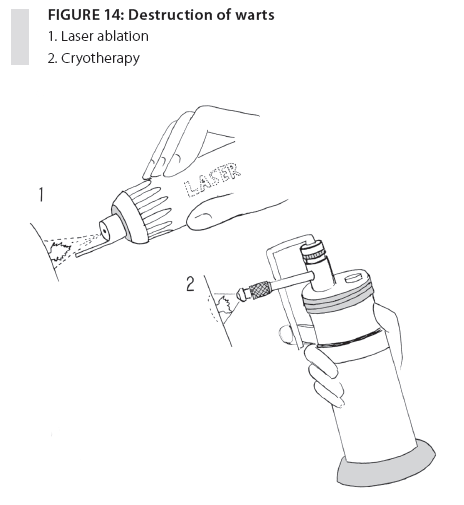
How common are infections from genital types of HPV in men?
According to the current epidemiological data and modern habits in the western world (frequent change of sexual partners in young ages), it is estimated that nearly all sexually active men are infected by certain genital types of HPV over their lifetime. In most cases, temporary local lesions are created, which go unnoticed and subside on their own within a few months. In some cases, however, there are visible genital warts. In very few cases, precancerous lesions may appear much later.
How are genital types of HPV transmitted in men?
Genital types of HPV are transmitted through sexual intercourse. A man may reduce the risk of infection by consistently using condoms throughout the entire duration of intercourse.
What do genital types of HPV cause in men?
After the infection, genital types of HPV may cause lesions, if the immune system allows it.
Most of these lesions are invisible and cause no symptoms. They are, therefore, called subclinical. In some cases, visible lesions appear, referred to as genital warts.
A long time after the infection and the first lesions by oncogenic types of HPV, there is a small chance of precancerous lesions appearing.
Infections are common but cancer is rare. There is a correlation with the type of the virus. Precancerous lesions and cancers are only caused by oncogenic types of HPV.
We describe below, in order of frequency, the lesions caused by genital types of HPV in men:
- Subclinical lesions
- Genital warts
- Precancerous lesions and cancer.
Subclinical (invisible) lesions
Most lesions are subclinical (cannot be found during a clinical examination, are invisible to the naked eye, and cause no symptoms). Throughout the duration of a subclinical infection, the man transmits the infection to his partner without being aware of it.
All genital types of HPV can cause subclinical lesions.
Subclinical lesions have a good prognosis. They subside on their own within a few months. No treatment is recommended for subclinical lesions but it is possible that they will recur.
Genital warts
Genital warts, referred to as condylomata accuminata in the medical texts, are benign infectious lesions and nearly 90% of them are caused by HPV 6 and 11. Other genital types of HPV are responsible for the remaining 10%.
About 1-3% of the male population will get genital warts by the age of 50. It is obvious that there is a higher possibility of genital warts in men:
- who have sex with a person suffering from genital warts
- who have sex with a person with a history of genital warts
- who have a history with a large number of sexual partners.
The possibility of transmission of the virus and appearance of genital warts is very high in those cases where at the time of sexual contact, the partner has genital warts (60-70% risk of transmission).
As regards the detection of genital warts in men, they usually appear on the penis. Less frequently, they appear on the pubis, scrotum, groin, and the perianal area (more frequently in homosexuals receiving anal intercourse). Perianal warts have been found in men with warts in the genital organs who have had no anal intercourse, obviously due to self-infection.
Genital warts cause no serious symptoms. Several patients report itching.
Precancerous lesions and cancer
In very few cases, and a long time after the initial infection with oncogenic types of HPV, precancerous lesions may appear. If precancerous lesions are not treated, they may develop into cancer.
In men, precancerous lesions and cancers caused byHPV have been described on the penis and anal area. Also, it is estimated that 25%-35% of head and neck cancers (oral cavity and throat) are attributed to genital types of HPV.
Precancerous lesions on the penis are internationally referred to with the initials PeIN (Penile Intraepithelial Neoplasia). The corresponding term used for precancerous anal lesions is AIN (Anal Intraepithelial Neoplasia). There are grades AIN 1, 2, 3 corresponding to the CIN, VIN, and VaIN lesions described in chapters 8 and 9. It is believed that AIN 2/3 lesions (also referred to as HSIL)
must be treated because there is a significant chance that they will develop into cancer.
Penile cancer: Penile cancer is exceptionally rare. However, a large percentage (40%-50%) of penile cancers is causally related to infection by oncogenic types of HPV. Around 600 penile cancers are reported every year in the USA (0.2% of cancers in men). Due to the rarity of the disease, no routine check-up is recommended. However, if any precancerous lesions are found on the penis, they must, of course, be treated.
As regards anal cancer in men: around 2,000 anal cancer cases are reported every year in the United States. Approximately 95% of anal cancers are attributed to HPV.
We know that, in male homosexuals, high-risk types of HPV cause precancerous lesions and cancer of the anal canal more frequently. AIDS patients are at a higher risk for carcinogenesis due to immunosuppression. There are efforts to establish routine check-ups for male homosexuals, with tests similar to those for the prevention of cervical cancer in women (Pap test and HPV test).
Finally, in regard to head and neck cancers: High-risk types of HPV are responsible for carcinogenesis in the mouth, pharynx, and larynx areas (described as head and neck cancers). The DNA of oncogenic types of HPV is found in 25%-35% of the cancers in these areas (usually HPV 16).
Head and neck cancers are not very common, and most of them appear in men after the age of 50. Smoking and alcohol abuse have always been considered causal factors. However, it is important to acknowledge that even some of these cancers are caused by oncogenic types of HPV, because they could be prevented with HPV vaccination in boys.
Which factors affect the risk of a man getting infected by HPV?
The risk increases with the number of sexual partners and the sexual history of each partner.
The risk decreases with the use of condoms.
Preventive vaccination, before becoming sexually active, provides a high rate of protection. It provides nearly 100% protection against the vaccine’s HPV types.
It is also worth noting that circumcised men have a smaller chance of chronic HPV penile infections. This does not mean that circumcision fully protects from the risk of infection. How is this explained? In circumcised men, the glans of the penis is not covered by the foreskin, the area is dry, and the epithelium is covered by keratin. In these conditions, it is not easy for HPV to cause chronic infections, because HPV prefers moist areas with metaplastic epithelium.






